
Issue Contents

Photo Essay:
Bhaktapur Retrospective
This retrospective, like many, is a look through rose-colored glasses. There are almost no motorcycles and few signs of the devastating earthquake that struck Nepal in April, 2015. It's the way I would like to remember Bhaktapur, not the way it was when I left. It is my fondest hope that someday it will again look like it does here.
Click on an image to open a bigger version in a new tab. Ctrl+w will close the new tab and return you to Carfree Times.
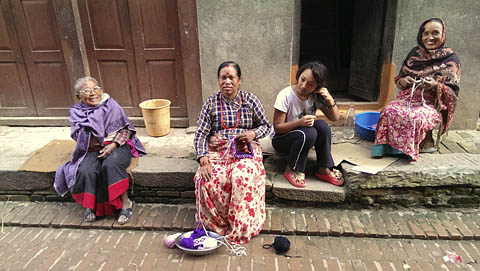
Socializing in public spaces is a daily activity.

2013 J.H. Crawford
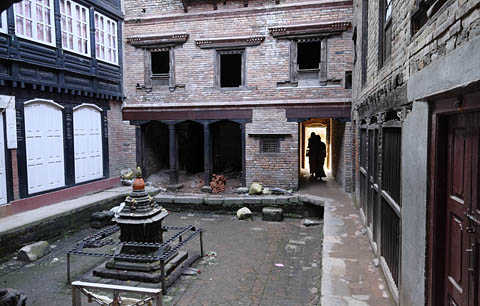
The casual observer will miss most of the interior courtyards
that bring light and air into the adjacent houses.

2014 Bansidhar Sainju
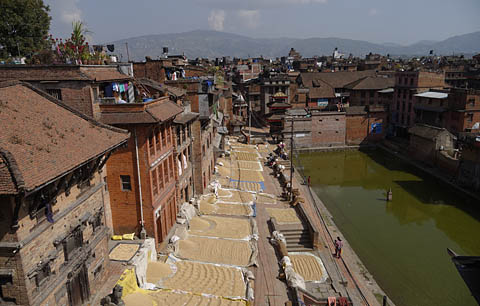
Grain drying in the autumn sun is a reassuring sight.
In Nepal, you are usually closer to your food supply
than in the West.

2014 J.H. Crawford
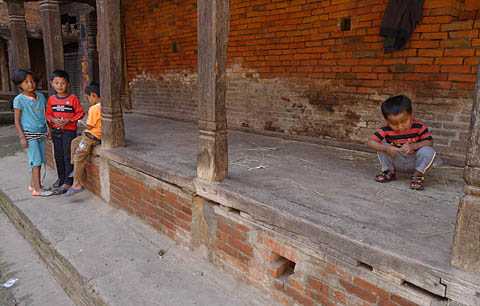
These public social spaces, sheltered from the sun and rain,
are used for many purposes.

2014 Bansidhar Sainju
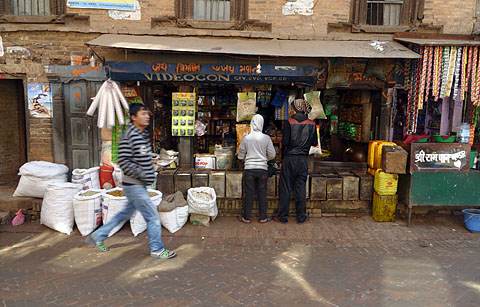
Shop fronts spill out into the street during business hours.

2014 Bansidhar Sainju
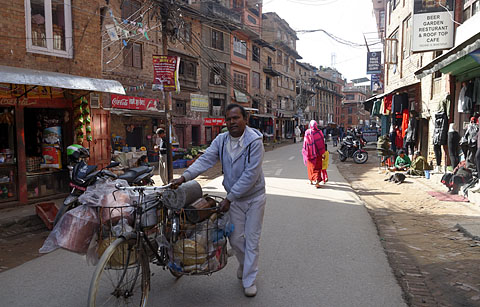
The bicycle is still a mainstay of local freight delivery.

2014 Bansidhar Sainju
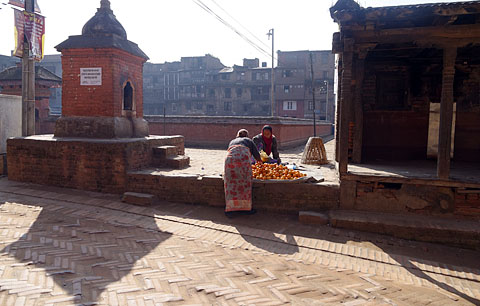
When the oranges come up from the plains of
southern Nepal, there are a lot of them.

2014 Bansidhar Sainju
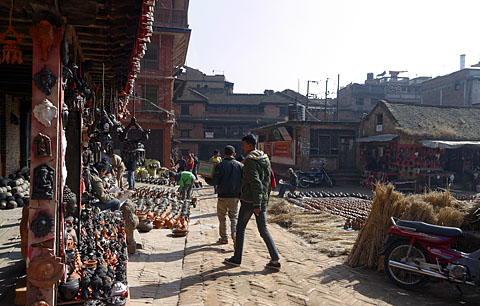
Pottery Square: if it's made from clay and then baked,
you can buy it here, right where it's made.

2014 Bansidhar Sainju
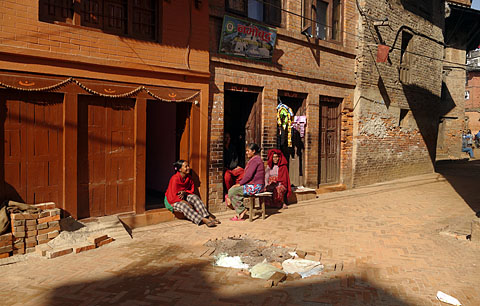
There's always time for a chat with friends and neighbors.

2014 Bansidhar Sainju
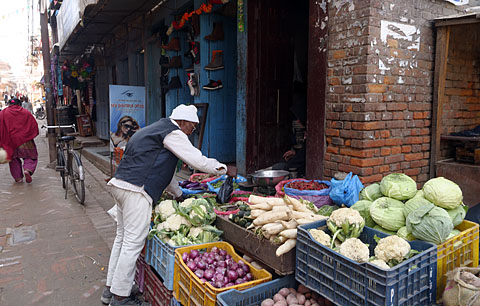
Local markets for local produce. Whatever you buy
will be fresh.

2014 Bansidhar Sainju
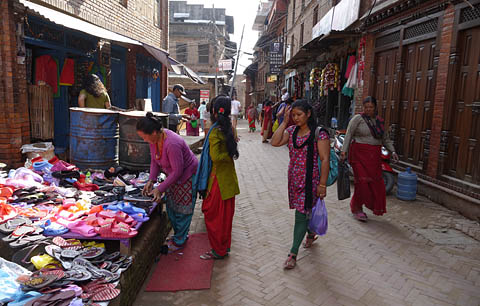
Nobody has much money, but most things are cheap.

2014 Bansidhar Sainju
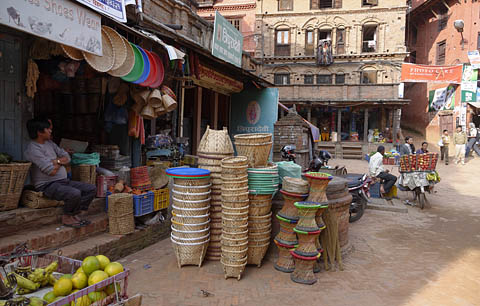
Wicker products are found everywhere. Plastic is common
but is mostly used for things that must be waterproof.

2014 Bansidhar Sainju
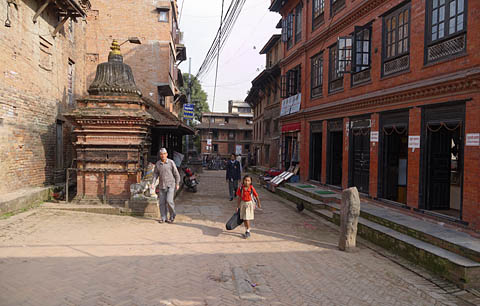
Temples are everywhere. In fact, most houses have one.
You barely notice them after a while.

2014 Bansidhar Sainju
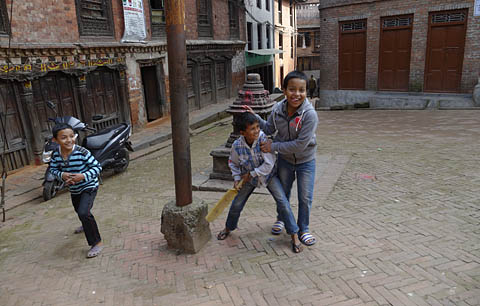
There are hardly any playgrounds as such. Kids just play
in the streets.

2014 Bansidhar Sainju
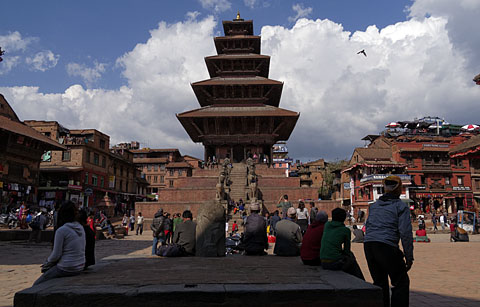
Nyatapola is the only five-story pagoda in Nepal.

2015 Dristy Shrestha
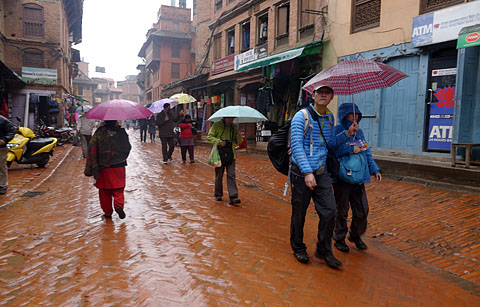
This winter rain is uncommon, unlike the
summer with its heavy monsoon rains.

2015 Bansidhar Sainju
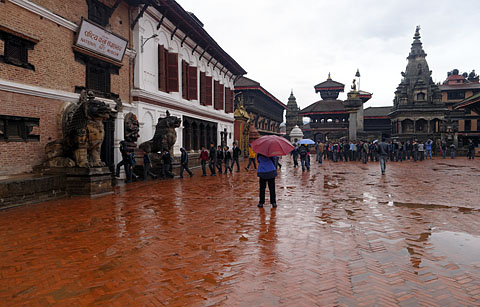
Bhaktapur's Durbar (Royal) Square before the earthquake.

2015 Bansidhar Sainju
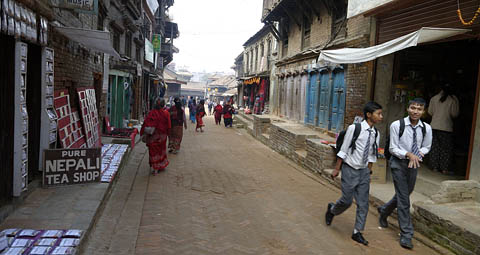
Most kids walk to school.

2015 Ram Kumar KC
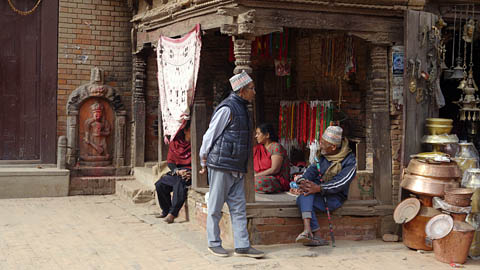
At festival time, it is acceptable to sell bright necklaces
from one of the social spaces.

2015 Ram Kumar KC
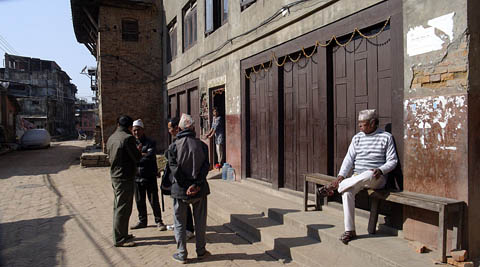
During the winter, all the popular social spaces will be in
full sun.

2015 Ram Kumar KC
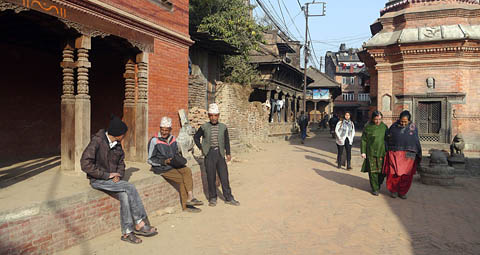
In just this one photograph, three separate covered
social spaces can be seen.

2015 Ram Kumar KC
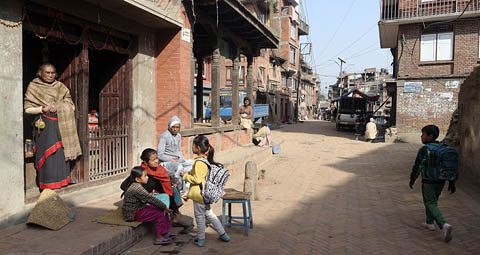
Much of life happens in the street. Kids soak up a great deal
of their culture this way.

2015 Ram Kumar KC
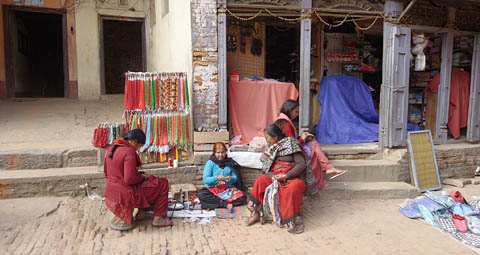
Making beads and selling them.

2015 Ram Kumar KC
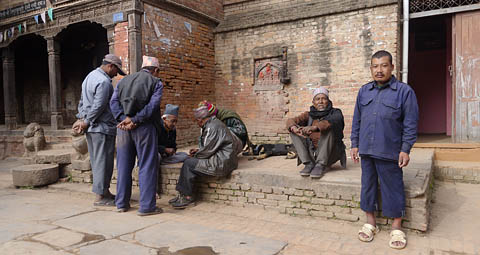
Many different games are played in the streets.

2015 Ram Kumar KC
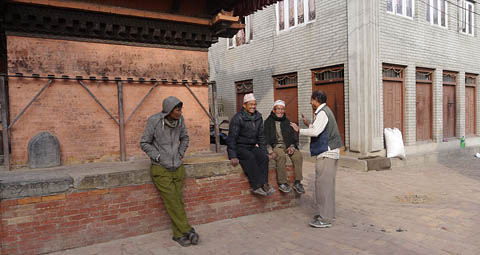
Most temples include extensive ledges that are excellent
for sitting and talking.

2015 Ram Kumar KC
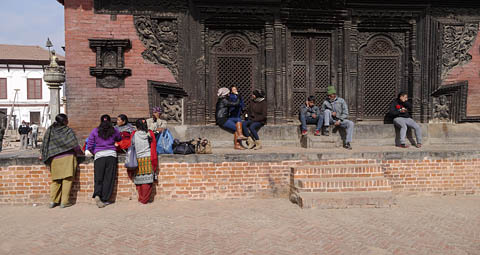
Another temple with well-used steps and ledges.

2016 Ram Kumar KC
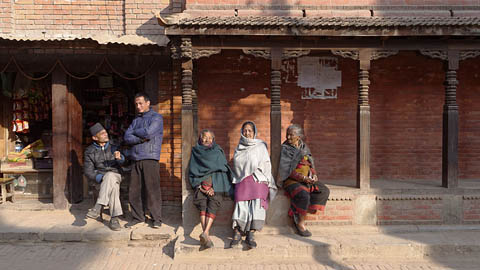
During the winter it's cool enough that sunshine is
much appreciated.

2016 Ram Kumar KC
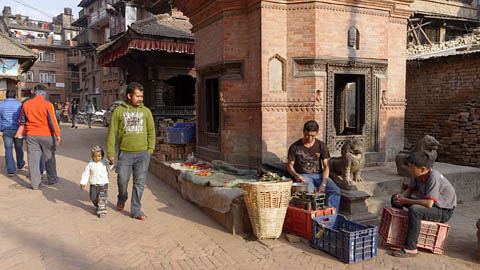
Commerce mixes freely with religion.

2016 Ram Kumar KC
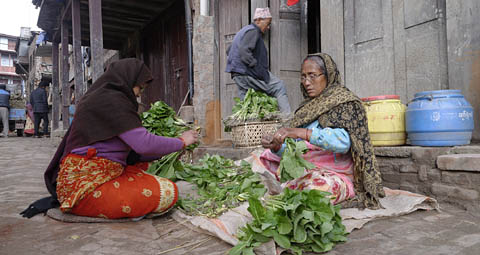
Fresh greens, picked just hours ago.

2016 Ram Kumar KC
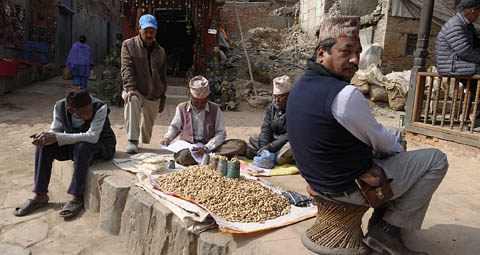
Nobody gets rich selling peanuts, but they do have
a pleasant afternoon.

2016 Ram Kumar KC
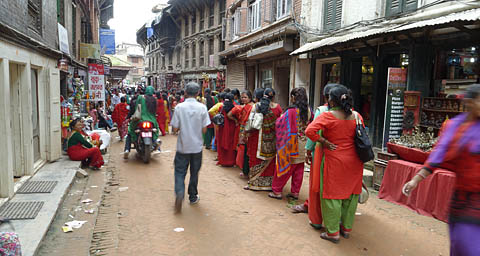
On holy days, women stand in line for hours awaiting
their turn at the temple.

2016 Ram Kumar KC
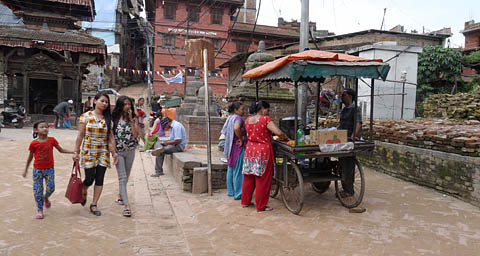
Carts made from bicycle wheels are a common and
practical sight.

2016 Ram Kumar KC

|

|

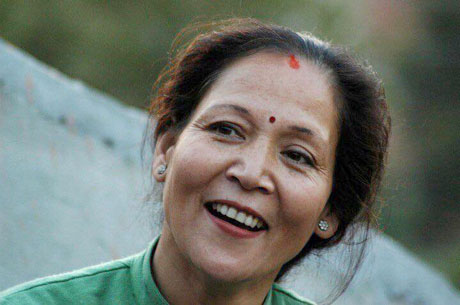
In Memoriam: Indira Bijukchhe
Indira Bijukchhe was 49 and the wife of Raja Man Bijukchhe, a good friend of mine in Bhaktapur. They were riding a motorscooter which was hit by a truck. Raja is recovering from his injuries.
I offer my condolences to the family for this tragic loss. This issue is dedicated to her memory.
Announcements
Carfree Conversions
The Conversions page at Carfree.com has been fairly extensively updated.
The Books
Carfree Cities and Carfree Design Manual are widely available from booksellers in Europe and North America.
Reminiscing
This seems to be a good moment to look back on three personally significant events of the past sixteen years.

1000 Days in Bhaktapur
Just two days before his wife was killed and he was seriously injured, Raja Man Bijukchhe urged me to write my recollections of the roughly 1000 days I spent in Bhaktapur, Nepal. This task is rendered more poignant by the tragedy that occurred so soon afterwards.
I first arrived in Nepal in late October, 2013, and proceeded directly to Bhaktapur from the airport. I spent nearly all of the following three years in Bhaktapur, leaving it only for a few relatively brief trips outside Nepal and one short visit to the Nepali city of Pokhara. Despite having spent three years in Nepal, I have seen little of the nation outside the Kathmandu Valley.
The Kathmandu Valley is in fact a paradise on earth, or at least it once was. The Valley is the bed of a former lake which appears to have drained naturally during human memory, leaving behind a very thick accumulation of rich, silty soil. The Valley is about 1400 meters above sea level, so it is nowhere near as hot as the Gangetic Plain that lies less than 100 kilometers to the south. It is surrounded on all sides by high hills, and the snow-capped Himalayas are (or used to be) frequently visible from the Valley.
This remarkable geographical condition is the source of both problems and gifts. The rich soil, combined with reliable monsoon rains, makes the entire Valley a highly productive agricultural area, and most crops can be grown there. The weather is quite temperate, although nights can dip to freezing in the coldest part of the winter. It never snows.
However, the very soft soils make the Valley highly vulnerable to the major earthquakes that shake the region about once a century. I was there for the magnitude 7.8 earthquake that struck on 25 April 2015. That earthquake caused about 9,000 deaths and the damage or destruction of countless buildings across much of Nepal, including a large number of culturally important structures. Bhaktapur itself was one of the hardest-hit areas. The city of Sankhu, only about 15 kilometers to the northeast, was all but destroyed during the earthquake and the magnitude 7.3 aftershock that followed 16 days later.
The earthquakes were followed a few months later by an economic blockade imposed by India in retaliation for Nepal's adoption of a constitution that India did not like. This resulted in great hardship for most of the people of Nepal, which only eased when the blockade was relaxed after about four months.
It is thus apparent that this was not an easy time to be living in Nepal. Despite these difficulties, I have no regrets about having lived there for a long stretch, and I miss the place and most particularly the many people I came to know there.
It is worth looking at the various ways in which Bhaktapur is such an agreeable place to live, as well as the threats to its generally high quality of life. Nepal is a poor nation, with a per-capita GDP of less than $1000. The reality is not quite as harsh as that number would suggest, and not many people in Nepal go hungry. Living conditions are basic but not primitive, and both healthcare and education are better than in many similarly poor nations.
What really changes the picture, however, is the richness of social life, at least in the parts of Nepal that I have seen. It is true that all the common human vices are to be found in Nepal, but in terms of social life, of all the other places I have visited, only Bali can rival the Kathmandu Valley for its strong social life. In both places it happens that the culture is founded on the Hindu religion, although the expression is quite different. In Bhaktapur as in Bali, if you live somewhere for a few months, you will come across many people who recognize you and will greet you as you pass.
It would be foolish to pretend that human affairs in Nepal are somehow idyllic. There was a civil war that ended only ten years ago and cost the lives of more than 10,000 people. The chief of the anti-corruption agency is defending himself against . . . corruption charges. The caste system was officially terminated but still governs much of daily life. In many cases, people feel their family obligations as a prison. Alcohol causes serious problems.
All this notwithstanding, I miss Bhaktapur. I don't miss the air pollution, which is what finally drove me to leave, and I don't miss the day-to-day difficulties such as load shedding [regular electricity cuts], shortages of cooking gas, and sometimes even water shortages. I do miss the people of Bhaktapur and their ready smiles and cheerful approach to the difficulties life sends their way. I have always regarded the social impacts of traffic as being the most important reasons to adopt the carfree city, and Bhaktapur is itself under threat from this cause, mainly from soaring motorcycle usage.
Bhaktapur is also an excellent model for a sustainable way of life. It is certainly not perfect, but per-capita consumption of non-renewable resources is low by any measure, and agricultural practices are generally more sustainable than the intensive chemical farming of the West. The form of the city itself is, by my reckoning, nearly ideal, with narrow streets, four-story buildings, and in many cases interior courtyards. This arrangement in fact resembles the one proposed in Carfree Cities and can be found, in varied forms, in most of the medieval cities of the world that have survived to the present day.
I look forward to the day I will be able to return to Nepal. There are reasons that this remarkable nation is so popular with serious travellers. I wish Nepal and the Nepalese a heartfelt "namaste."

3650 Days Since the Car Crash
It has now been ten years since the neighbor boy, driving far too fast on a narrow country road, smashed into my parents' stopped Prius and effectively ended their lives. They both lived three more years and died just 16 days apart, but their lives essentially ended with the crash.
My mother was institutionalized on a ventilator for the remainder of her life, which was spent mostly in bed. Drugs administered to her in the first weeks of her hospitalization also damaged her brain, so she never read again, something that had been one of her great passions.
My father already suffered from serious dementia at the time of the crash. Up until that point he had been cared for by my mother. After the crash, he was cared for by strangers except for a few months when I was able to bring him home, before his dementia worsened to the point where he had to move into assisted living and finally into the same nursing home as my mother.
It is so that some of their caregivers were wonderful people and did their best to give them a decent final few years of life, but circumstances were against them. I would like once again to thank them for their care and compassion.
The death of Indira Bijukchhe again brought the terrible consequences of bad vehicular crashes into sharp focus for me, and I was reminded anew of the awful pain and suffering they cause, not only to those involved directly in the crash but to their loved ones. This toll will probably never disappear entirely, but it simply cannot be tolerated on the scale that it occurs today. Millions of people are killed or maimed every year on the world's roads, and millions more die of the effects of air pollution, much of which can be traced, directly or indirectly, to motor vehicle use.
Given that we perfected rail transport decades before the first primitive Mercedes Benz appeared on the streets, one can only ask why this slaughter is tolerated. Trains do occasionally crash, but they are about an order of magnitude safer than cars, and their environmental impacts are comparably smaller as well.
I think a large part of the answer lies in corporate interests. In the United States, we have a roughly 90-year history of the "road gang" (see Stephen B. Goddard's Getting There: The Epic Struggle Between Road and Rail in the American Century) manipulating public perceptions and influencing public policy in a direction that made vast fortunes for the various highway interests while destroying huge swathes of American cities and killing millions of Americans.
As with so many aspects of American life, it is time for common sense and the common good to seize control over private interests that manipulate the public realm for private profit. Enough is more than enough.

6000 Days Since Carfree Cities
Eric Britton at EcoPlan recently encouraged me to write a brief retrospective on the time since Carfree Cities was published in early 2000, about 6000 days ago. What has happened since then, and where are we now? How does the book stand up after 16 years?
The book enjoyed surprising early success and went on to a second printing two years later. The first edition has been sold out for years, and only a few copies of the paperback edition are still available. Quite a lot of this success was due, I think, to a relatively extensive North America promotional tour that lasted about two months, involved about two dozen talks, and garnered considerable media attention, especially in Canada.
The carfree idea is, of course, as old as cities, except that nobody noticed until the first cars appeared, an event that generated considerable resistance to their intrusion. Ultimately, the road gang prevailed. Streets became the exclusive domain of cars, and many children no longer had anywhere to play. Death in the street became an "accident," for which the pedestrian was usually held responsible. The suburbs became an obvious destination for families, where the impacts of the automobile were not so strongly felt.
My generation, the baby-boomers, was really the first American generation that grew up mainly in the suburbs, long before "stranger danger" became standard-issue paranoia. We got around by walking, biking, and sometimes public transport, and so we had a great degree of freedom. This was a time of unprecedented prosperity and almost unrivalled American dominance in every sphere. Having known nothing else, we believed this was a normal state of affairs, and our complacence persisted until the Vietnam war and the gasoline shortages of the 1970s.
Most of my generation is still fit enough to drive, so the limitations of an auto-centric society have not yet affected them directly, and most of my generation still don't see anything much wrong the auto-centric suburban model. This is only now starting to change.
With the Millennials, the situation is quite different. By the time they came along, the auto-centric model wasn't working very well, and they never had much freedom to get about, whether on foot, by bike, or on public transport. As kids, they were driven almost everywhere they went, and they had to rely on parents for their social contacts. The Millennials are not terribly enthusiastic about cars. Their prospects generally look rather grim, as they appear to be mostly priced out of the suburban dream their parents took for granted. So, they have reason to look towards other urban models. They also find cities more interesting and attractive than earlier generations.
If the Millennials decide to turn to carfree cities as a way to solve a host of problems, including social breakdown, economic inefficiency, and damage to the environment, they will find the carfree model ready and waiting. Even in America, it is no longer remarkable for a city to declare some of its streets carfree, sometimes temporarily, sometimes permanently. Today, most European cities have at least a small carfree area, usually downtown, which is often the center of cultural and social life.
When the world is ready to take up the carfree concept on a large scale, it will find that the thinking is largely complete. Some technical development, particularly in the matter of freight delivery, will be needed, but the basic concepts already exist, and most have already been prototyped.
So, in short, if I were to rewrite Carfree Cities today, there is not much that I would change. My preference for fine-grained, small-scale urban areas has further increased, and I have changed my mind about street trees (in favor), but otherwise I believe the book stands as it was written in the late 1990s. I only hope that the principles that it espoused will be much more widely applied 6000 days from now.

News Bits
The links below will open in a new browser window or tab, depending on your browser; (Ctrl+click) may behave differently:

Urban Planning and Design
"The curse of urban sprawl: how cities grow, and why this has to change"
The Guardian's Mark Swilling says it is time to stop the sprawl.
"The total area covered by the world's cities is set to triple in the next 40 years - eating up farmland and threatening the planet's sustainability.
"I have just spent two days in Barcelona, one of the most densely populated urban settlements in the world . . . . Yet despite these high densities, residents of Barcelona will tell you how profoundly livable their city is. Visitors are charmed by the pedestrianised streets that thread their way through a maze of buildings constructed over the centuries - between four and seven storeys high, on narrow streets leading to piazzas where people sit at cafe tables or under shady trees. Many residents walk or cycle to work, and public transport functions very well."
This pretty nearly defines the carfree city as proposed in Carfree Cities. (TheGuardian.com)
"3-Minute Read: Here's What Happened When A Neighborhood Decided To Ban Cars For A Month"
"Everyone loved it, obviously. And the world didn't fall apart." Really, it's time people stopped being so freaked out by this idea. (FastCoexist.com)
"Paris divided: two-mile highway by Seine goes car-free for six months"
"A busy expressway on the right bank is being pedestrianised for a six-month trial - and socialist city hall hopes to keep it car-free for good. The issue has bitterly divided Parisians, with some saying the closure will bring traffic to a standstill." Yes, a few thousand motorists, mostly residents of the suburbs, will be inconvenienced for the health and happiness of an entire city. Seems like a good bargain to me. (TheGuardian.com)
"The morbid and mortal toll of sprawl"
"The 'elephant in the living room' of rising and preventable US traffic deaths and injuries is government-funded roads in drive-only places . . . . The human cost is harder to calculate. Although motor vehicle accidents rank around 10th in causes of death in the US, they are the most frequent reason for fatality of children 5 and up and young adults. In terms of life years lost, motor vehicle crashes rank near the top - in this study, third behind coronary attacks and strokes [to which the drive-everywhere infrastructure also contributes]." A glance at the lead photo is all you need to understand that you would have to be desperate to walk in these places. (CNU.org)
"Cubic and Mastercard study shows impact of New York's car free day"
"The one-day event resulted in an increase of more than 30,000 passengers than the season's daily average on the MTA subway, while public data for other services like bike share also showed a statistically significant increase in usage.
"For retail stores, there were no significant adverse effects on commercial activity in the surrounding areas, despite road closures created to facilitate and support the spirit of the event." (ITSinternational.com)
"Car-free Belgium: why can't Brussels match Ghent's pedestrianised vision?"
In Ghent, 72% of people favour plans to expand the pedestrian zone by 15 hectares, and another 17% are neutral. In Brussels, renowned for terrible traffic, the key failure was that, despite the support of 85% of local shopkeepers for carfree spaces, some 92% said the plans had been badly implemented. This is a very typical failure.
The resistance to carfree zones in Belgium is encouraged by the sense that cars are status symbols and by tax breaks for car ownership. (TheGuardian.com)
"Burying a 1950s Planning Disaster"
"The partial removal of the Inner Loop might make Rochester, New York, the city that finally breaks a ruinous mid-century mold." To get an idea of the scale of the devastation caused by urban freeway construction, have a look at the before-and-after photos. (CityLab.com)
"Will we ever get a truly car-free city?"

Moving Walkways Revisited
In Carfree Times #28 (2002), I reported on a chance encounter in Paris with an under-test moving walkway that ran at speeds of up to 9 km/hr, with twice that speed in the realm of possibility.
(See: "Moving Walkway at Montparnasse") The system was eventually removed due to problems with the technology but most especially because users often failed to make the speed transition properly and fell down. People did not understand, despite clear signage, that they simply must grasp the handrail during the acceleration phase or they would be very likely to suffer a fall. I saw two people fall during a quarter of an hour observing the Paris system.
This technology resurfaced a few days ago and was reported quite extensively:
"Could moving walkways be the key to car-free cities of the future?"
"'This study proves that the concept is credible and that a car-less, pedestrian-centric city is conceivable,' said researcher Michel Bierlaire." (UPI.com)
and
"Fast moving walkways could move 7,000 people per hour"
"It was with this in mind that EPFL's Transport and Mobility Laboratory studied accelerating moving walkways, which can go up to 15 km/h, to see if they could compete with other means of transport." (Phys.org)
and
"Moving walkway networks would be an efficient transport option for car-free cities"
"Researchers at EPFL looked at the idea of car-free cities and, using Geneva as a model, they concluded that Jetson-style moving walkways could not only replace the car, but could each carry 7,000 passengers an hour more energy efficiently than buses." (NewAtlas.com)
A little digging revealed that the ThyssenKrupp Express Walkway uses a different technology, and it appears that the acceleration is lower, which may have solved the problem of falls. The system is apparently not yet perfected - it is said to be noisy and unreliable.
Still, as I said to the engineers in Paris, if the system could be made to work, it would make the carfree city a good deal easier to attain. They clearly already understood this.

Climate Change
"Scientists 'too frightened' to tell truth on climate impacts"
"Sooner or later, there will be an unbridgeable gulf between global food needs and our capacity to grow food in an unstable climate. Inevitably, starvation will reduce the world's population." This is the nightmare scenario I have been striving to avoid. (ClimateChangeNews.com)
Please watch our 53-minute film, "Recovering from Disruption," which gives concise proposals to address the major climate threats.
"Forget Paris, Scientists Say 'Radical Change' Only Way to Stay Below 2 Degrees"
"Study by former IPCC chair comes amid rash of new research, all predicting the Earth will soon blow by key global warming thresholds." (CommonDreams.org)
"Unified Against Trump Threat, World Vows To Push Ahead on Climate Action"
"'Climate change is not going to wait for U.S. action and the rest of the world is clear it is moving forward,' said a campaigner." We really have no idea who Trump is or what he actually plans to do. We need to be ready for anything. (CommonDreams.org)
"Canada will tax carbon emissions to meet Paris climate agreement targets"
Now I suppose Trump will have to build two walls. The carbon tax is such a no-brainer (along with ending subsidies for fossil fuels) that it's hard to understand why it hasn't been implemented everywhere. Politicians should love this tax! (TheGuardian.com)
"Why Morocco is leading the charge against climate change"
Morocco is a developing nation that is preparing to lead the rest of the world into a sustainable future.
"In 2014 the country opened the largest wind farm in Africa, valued at $1.4 billion, in the southwest near the city of Tarfaya. Then, in early 2016, it switched on the first facility of the world's largest concentrated solar plant, Noor-1, on the fringe of the Sahara desert. When completed in 2018, it will power one million homes and make Morocco a solar superpower.
"And while the country is still heavily reliant on energy imports (90 percent in 2013, according to the World Bank), it plans to generate 40 percent of its energy from renewables by 2020.
"Following this road has led to Morocco hosting the UN's annual summit on climate change, COP22, in Marrakech."
At some point, the developing nations are going to turn on the rich nations and say, "If we can do this, certainly you can, too." That will be a challenge nobody can ignore. (CNN.com)
"Sarkozy proposes carbon tax on US goods if Trump scraps Paris climate pact"
I strongly dislike Sarkozy, but he's spot-on with this proposal. (RFI.fr)
"Nepal Is Showing the Way on Climate Change"
"You wouldn't know it driving around polluted Kathmandu, but Nepal is very much a leader in the fight against climate change. For a poor country struggling with severe poverty, it is more than a little admirable how much Nepal has done already to decarbonize its economy. " (HuffingtonPost.com)
"'The Mother of All Risks': Insurance Giants Call on G20 to Stop Bankrolling Fossil Fuels"
"Multinational firms managing $1.2tn in assets declare subsidies for coal, oil, and gas 'simply unsustainable'" A carbon tax may be politically contentious, but could we not at least agree not to subsidize climate change? Subsidies might actually get reconsidered, given that a gigantic industry is calling for their end. (CommonDreams.org)
"Oceans act as a 'heat sink': No global warming 'hiatus'"
The alt-right claims that there is no global warming because global temperatures did not rise for 15 years. There was, however, no hiatus; the oceans were simply absorbing the extra heat by warming up. That grace period, which we failed to use to our advantage, now appears to have ended, and temperatures are rising rapidly. (ScienceDaily.com)
"Ground beneath our feet is poised to make global warming much worse, scientists find"
Climate feedback loops include the release of carbon bound in the soil. It is now thought that this will be one of the prime drivers of atmospheric CO2 increase in this century. (NewsMiner.com)
"Sea ice hits record lows at both poles. What does it mean?"
"Arctic sea ice hits second-lowest extent in satellite record"
What's even more alarming is that Arctic sea ice extent, which should be growing rapidly at this time of year, saw significant declines for several weeks. At the same time as it has been extremely warm in the Arctic, it has been extremely cold in Siberia. (ADN.com)
"Greenland's huge annual ice loss is even worse than thought"
"The huge annual losses of ice from the Greenland cap are even worse than thought, according to new research which also shows that the melt is not a short-term blip but a long-term trend.
"The melting Greenland ice sheet is already a major contributor to rising sea level and if it was eventually lost entirely, the oceans would rise by six metres around the world, flooding many of the world's largest cities." (TheGuardian.com)
"West Antarctic Ice Shelf Breaking Up From the Inside Out"
"Studies have suggested that the West Antarctic Ice Sheet is particularly unstable, and could collapse within the next 100 years. The collapse would lead to a sea-level rise of nearly 10 feet, which would engulf major U.S. cities such as New York and Miami and displace 150 million people living on coasts worldwide." (ScienceDaily.com)
"Arctic ice melt could trigger uncontrollable climate change at global level"
"The Arctic Resilience Report found that the effects of Arctic warming could be felt as far away as the Indian Ocean, in a stark warning that changes in the region could cause uncontrollable climate change at a global level." We're all in the soup now. (TheGuardian.com)
"Human-caused climate change has been happening for a lot longer than we thought, scientists say"
"Using paleoclimate records from the past 500 years, the researchers show that sustained warming began to occur in both the tropical oceans and the Northern Hemisphere land masses as far back as the 1830s - and they're saying industrial-era greenhouse gas emissions were the cause, even back then." In fact, it is claimed by others that the Romans permanently altered the climate of North Africa by cutting down its forests, which have never recovered. (WashingtonPost.com)

Transport, Pollution, etc.
"Feds get out of the way of communities that want to design safer, more complete streets"
"The FHWA finalized new street design guidelines that scrap the bulk of the criteria that local communities and states must adhere to when building or reconstructing certain roads - especially those with speed limits under 50 mph. Of 13 current design criteria for certain roads under 50 mph, 11 criteria have been scrapped, because, in FHWA's words, they have 'minimal influence on the safety or operation on our urban streets.'"
This sounds like the kind of thing only a policy wonk could love, but in fact it's a major change in the way the federal government regulates street construction, and these changes should have large, positive effects on the livability of American cities. The "level of service" metric has at last been scrapped. (This led to many dangerous practices such as sweeping turns at intersections so a driver could take the corner at higher speed.) It probably caused the deaths of tens of thousands of Americans in the past 50 years. (SmartGrowthAmerica.org)
"The world's worst traffic: can Jakarta find an alternative to the car?"
Jakarta, population 30 million, is the largest city in the world that does not have a metro. When I was last there, more than 25 years ago, traffic was already awful.
"The government is allowing low-density development outside the city, and the wider metro area is spreading. That makes it difficult for public transport because there isn't the coverage. We need high density development where your first option is walking or cycling, and for longer journeys you can use the bus or metro.
"Attracted by the air-conditioning and the status, many of the 3.5 million people who commute into the hot and humid Indonesian capital come by car. With four hours in traffic not unusual, Jakarta is searching for solutions."
The matter of cars and status is a large problem everywhere, but it's huge in Asia. (TheGuardian.com)
"The End of Public Transit?"
"Cities such as New York and San Francisco have extensive public-transportation systems that carry millions of residents by bus, train, boat, and light rail. But in recent years, there's been an expanding fleet of private vehicles too: Lyft, Uber, Juno, Uber Pool, and the Google Bus, to name a few. These offerings give commuters more choices, but may also undermine the public services available. They raise fundamental questions about the future of how people will get around cities."
There can be no question but that this poses a serious threat to urban public transport as we know it. The proliferation of millions of additional private vehicles will damage the livability of cities and the quality of the environment.
Bus service in New Jersey, where I am staying for the moment, is worse than at any time I can recall. There is no one thing that's wrong - it's everything all at once. I confess, in the face of this difficulty, to sometimes using Uber and Lyft myself.
This article sounds like it was written by a right-wing think tank, so take it all with lots of salt. (CityLab.com)
"Why We Don't Drive In Los Angeles: LAist Readers React"
"Of the 1.3 million households in L.A. city, 280,000 of them are entirely car-free." That's actually quite a few in light of the generally poor state of public transport. (LAist.com)
"D66: De snorfiets moet de wereld uit [Doing away with the scooter]"
The Amsterdam arm of the national Dutch party D66 is proposing to entirely ban the "snorfiets," which covers a range of motorized two-wheelers that does not include motorcycles. The Amsterdam party is proposing that this measure be adopted in D66's national election platform. This filthy, noisy, dangerous invention of the devil (I exaggerate only slightly) has become so popular in Amsterdam that the only reasonable measure is to ban them entirely. While we're at it, we need to pay attention to e-bikes as well, as they, too, will be modified for excessive speed and endanger pedal-bikes riding properly on the bike paths. (Parool.nl)
"Half of injuries treated at SF General Hospital are from traffic collisions"
We tend to focus on traffic deaths and overlook the human and economic costs of traffic injuries. This study shows that those costs are huge and affect about 100 times as many people as fatalities, which are themselves shockingly high. (SFexaminer.com)
"Undercover bike cops launch 'best ever' cycle safety scheme in Birmingham"
The biggest problem: "I didn't see the bike." That would probably be because you weren't looking. (TheGuardian.com)
"Commuters Reduce Their Crash Risk by More Than 90 Percent When Taking Public Transit Instead of Driving"
This comes from the American Public Transportation Association, which might be considered to have an axe to grind. Whatever the exact numbers may be, you're a lot safer on a bus than in a car. (APTA.com)
"Car-Free Bridges: Are They the Future?"
The newest major bridge in Portland, Oregon, is carfree. Is it a trend? (GovTech.com)
"On yer bike! Cyclists take most comfortable route over quickest"
Wow, I would never have guessed that millions of other people do the same thing I do. People will go pretty far out of their way to use dedicated cycle lanes. (DutchNews.nl)
"Bike jams and unwritten rules: a day with Amsterdam's new 'bicycle mayor'"
"While bikes account for an estimated 68% of journeys made in the city centre, they are allocated just 11% of infrastructure space, with cars getting 44%." All is not sweetness and light as far as cycling in Amsterdam is concerned, but I will ride a bike there myself, and I won't ride in New York. It's worth noting that it was kids in Amsterdam who first protested the overrunning of their city by cars. This was back in the 1970s, when kids were thought sometimes to have interesting ideas. (TheGuardian.com)
"Cycle lanes don't cause traffic jams: they're part of the solution"
Read this if you need to argue with people who hate bikes lanes. (TheGuardian.com)
"Air Pollution in Bolivia's La Paz Falls by 72% on Car-Free Day"
"Bolivia's National Pedestrian Day was hailed as a huge success by environmentalists. Bolivians breathed a huge sigh of relief Sunday as the streets in major cities were cleared of all motorized vehicles. The air they were breathing was significantly cleaner thanks to the annual car ban." The buses look like a significant contributor, and they were gone, too. Electric buses, anyone? (TeleSurTV.net)
"Transport and climate: rail is the undisputed Number One"
"Powered by green electricity: rail is more climate friendly than coach, plane and car." While this is undoubtedly true, walking and cycling are even better. Relatively dense carfree cities require people to travel fewer miles in their daily lives than any other practical arrangement, and a lot of that mileage can be covered on foot or by bike. (Allianz-Pro-Schiene.de)
"How the FRA is Regulating Passenger Rail Out of Existence"
This sounds like another irrelevant policy-wonk discussion. When I was in railroading, the FRA was usually referred to as the "F**king Railroad Administration" because it prevented any creative thinking to be applied to US railroading. This is a rather brief summary of some complex issues, and it's well worth reading as background information. The upshot is certainly that expansion of passenger rail service in the USA is seriously hampered by FRA regulations. (BikeEastBay.org)
"The Tallinn experiment: what happens when a city makes public transport free?"
This is a long, complex discussion that should be read by anyone interested in fare-free urban public transport. I strongly favor it myself. Once all car usage is taxed at rates that reflect the damage it does, there will be plenty of money to operate free public transport in cities. (TheGuardian.com)
"92% of the world's population exposed to unsafe levels of air pollution"
"A new WHO air quality model confirms that 92% of the world's population lives in places where air quality levels exceed WHO limits. Some 3 million deaths a year are linked to exposure to outdoor air pollution." (ScienceDaily.com)
"De schone bus komt er aan [The clean bus is coming]"
Fifteen years ago, I proposed the short-wire tram. The idea has finally been implemented, but with buses rather than the trams I had originally envisioned. It's easier to do with trams, but apparently it can also be made to work with buses. (NRC.nl)
Electrically-propelled buses are becoming much more common these days, and some of them simply have large enough batteries to run the full length of a route without the need for en-route recharging. See: "Amsterdam to replace diesel buses with electric vehicles"
(DutchNews.nl)
"Agrichemicals and ever more intensive farming will not feed the world"
"They have reinvented their agriculture in a way that makes the science of agrochemical use look as primitive as a blunderbuss. Instead they employ groups of highly trained African scientists to study and reproduce in labs the fungi and microrrhizae in healthy soil that form intricate links with plant roots. Rather than waging chemical war on the land, they are working to harness its immensely complex ecosystems. They have built vast greenhouses dedicated to breeding and harvesting ladybirds [ladybugs] to control pests biologically rather than chemically." (TheGuardian.com)
"America's road trip: will the US ever kick the car habit?"
"Motor City Detroit built the automobiles, oil capital Houston fuelled them and Los Angeles was carved up by freeways in their honour. Yet now all three cities are pushing walking, cycling and the use of public transport. So does this mean America's love affair with the car is finally waning?" (TheGuardian.com)
"This Country Just Unveiled a Hydrogen-Powered Passenger Train"
It uses a hybrid system with a hydrogen fuel cell as the onboard energy source. On heavily-travelled lines, overhead wires probably make more sense, but on lightly-used branch lines, this can replace stinking, noisy rail-diesel-cars (RDC). The USA had hundreds of Budd RDCs in the post-war years. Most are now gone, but they are still common enough elsewhere. They are better than diesel buses and much better than cars, but they are still diesels. These hybrid trains offer a cleaner alternative, and they can be powered, indirectly, by sustainable electricity. (See this Wikipedia article for background on hydrogen-powered rail vehicles.) (Fortune.com)
"China's first suspension railway completes test run"
I remain staunchly opposed to overhead transit systems, but they can apparently run on batteries, if anyone is interested. (XinhuaNet.com)
"Transport Databook"
I haven't delved into this site, but it seems to be a mine of charts relating to many aspects of transport. (TheTransportPolitic.com)

About Carfree Times
Next Issue
The next issue of Carfree Times is scheduled for February/March 2017.
Subscribe to Carfree Times
Carfree Times is published quarterly at Carfree.com.
To receive e-mail notices of new issues, please visit the subscription page or
send e-mail with the word "Subscribe" in the subject line. We do not share our mailing list.
Write for Carfree Times
Interested in writing for Carfree Times? We welcome articles on a wide variety of subjects and offer an opportunity to publish letters to the editor and guest editorials. Drop us an e-mail.
Statement of Ownership
In this day of corporate-influenced media, Carfree.com declares its ownership and sources of support at the end of each year.
Carfree.com is wholly owned by Joel Crawford, the legal name of author J.H. Crawford. Its operation is financed by J.H. Crawford. It generates no revenues directly but does help support book sales. Carfree.com accepts review copies of books but makes no commitment to review them. J.H. Crawford receives no commissions from the sale of books mentioned on Carfree.com.
The views expressed at Carfree.com are those of J.H. Crawford, except for articles, letters, editorials, photographs, and films that carry the names of other authors. The inclusion of these signed texts is at the sole discretion of J.H. Crawford, who does not necessarily agree with the views expressed. All other content, except quoted material, is written by J.H. Crawford.
E-mail announcements of new issues of Carfree Times are mailed to approximately 750 subscribers. A rough estimate of first-year circulation for each new issue is 5000. All the issues ever published are still being read. Carfree.com as a whole will have served approximately 1.5 million pages and 100 GB of files in 2016.

Back to Carfree.com
Carfree Times Home
Back to Carfree Times Issue 83
Forward to Carfree Times Issue 85
E-mail
carfree.com
Text and illustrations, except for guest content, placed in the public domain

|